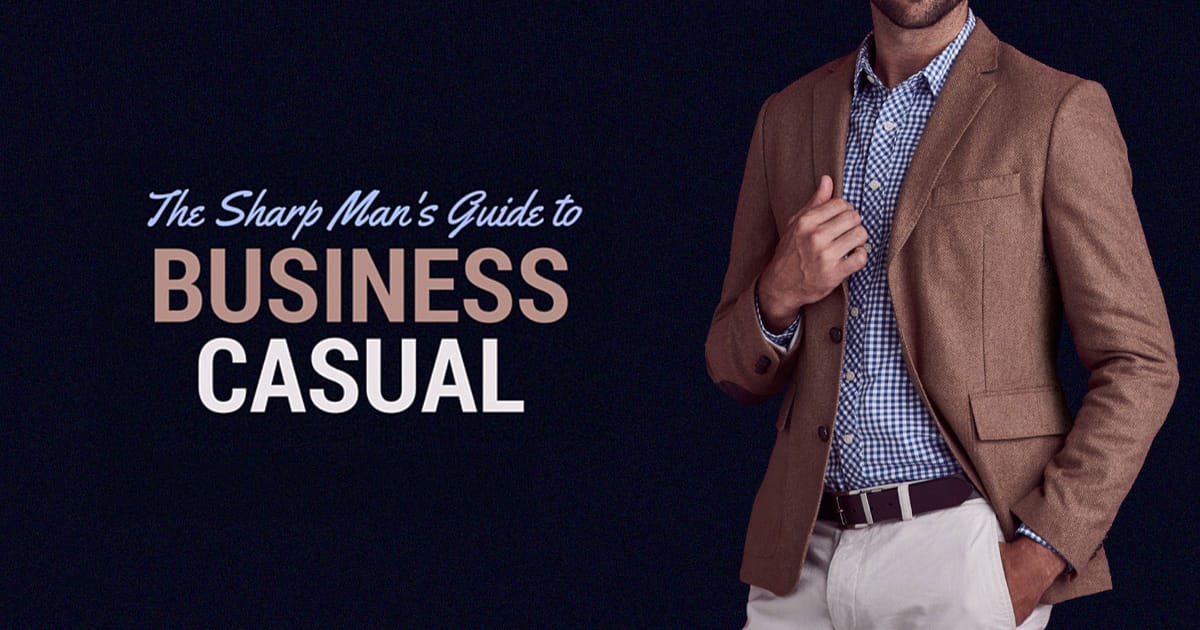
Apparently, many men still think a business-casual dress-code allows jeans.
It doesn’t.
But I understand the confusion. Frankly, everybody seems to have a different opinion on what counts as proper business-casual attire.
And that’s a problem because many guys will google it, read a bunch of articles and deduct that they have plenty of leeway. So they end up dressing as close to casual as they can.
But that leeway is imaginary.
When an office or event sets a dress code, they expect you to dress up to a certain standard.
But because the standard for business casual differs from office to office, a clear definition doesn’t exist. And that’s the root of the problem; defining a term that means something different to different people is difficult.
But as you know, I thrive on simplifying things that are difficult, so I’m gonna give it a shot. You can be the judge if I succeed.
Defining “Business Casual”
So the first thing you should understand is that business casual is not a casual look. It’s a look meant for business purposes.
The idea behind business casual is to project a professional image while enjoying more casual attire. You must appear neat and groomed, and yet, relaxed at the same time. But never too relaxed.
You can’t just wear the same clothes you’d wear to your neighbor’s barbecue or to your favorite bar, even if you dress them up.
Business-casual is not dressing up a casual outfit; it’s dressing down a business outfit.
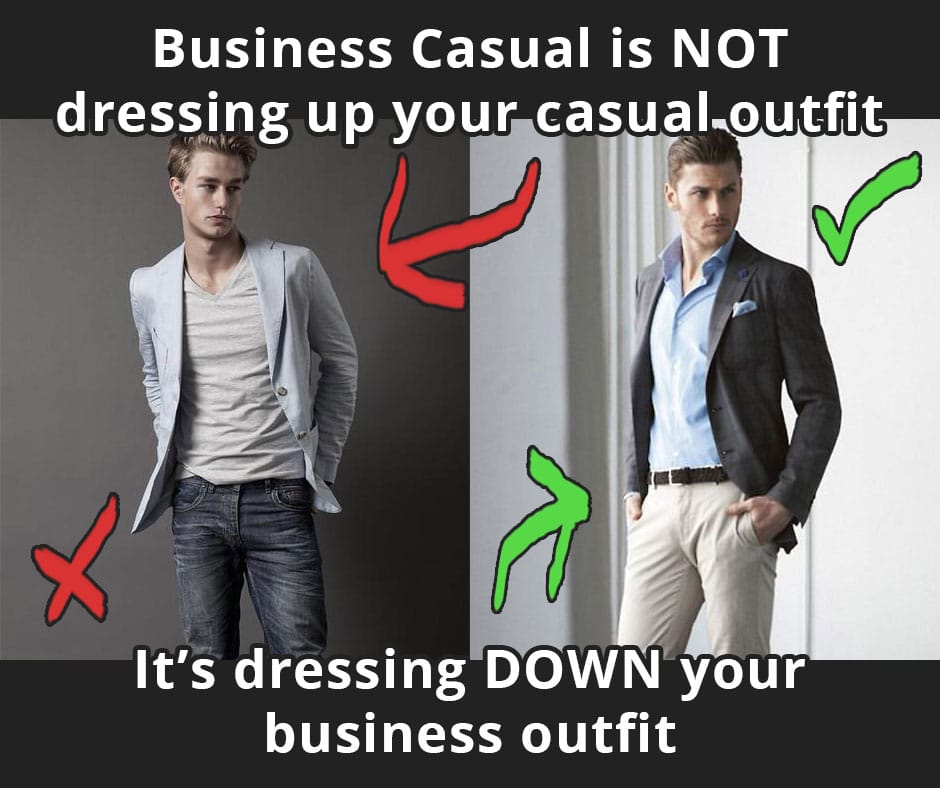
In other words: Business casual is dressing down from a suit.
That’s the definition you should follow.
But I know that’s not enough to clear up the confusion, so let’s give you some guidelines to follow.
Your Basic Business-Casual Guidelines
So you want to dress down from a suit, but what exactly does that mean?
Well, first off, your clothes should always be clean, unwrinkled and have at least some formal elements. You should, at the very least, wear a collar.
And your clothes should always fit you properly, which the well-dressed man should always ensure, even when dressing casual, but it becomes even more important when dressing for business purposes. After all, you don’t want to make a sloppy impression on a potential client or employer. It could hurt your career.
Also — and you may not like hearing this — T-shirts, jeans and sneakers are off limits.
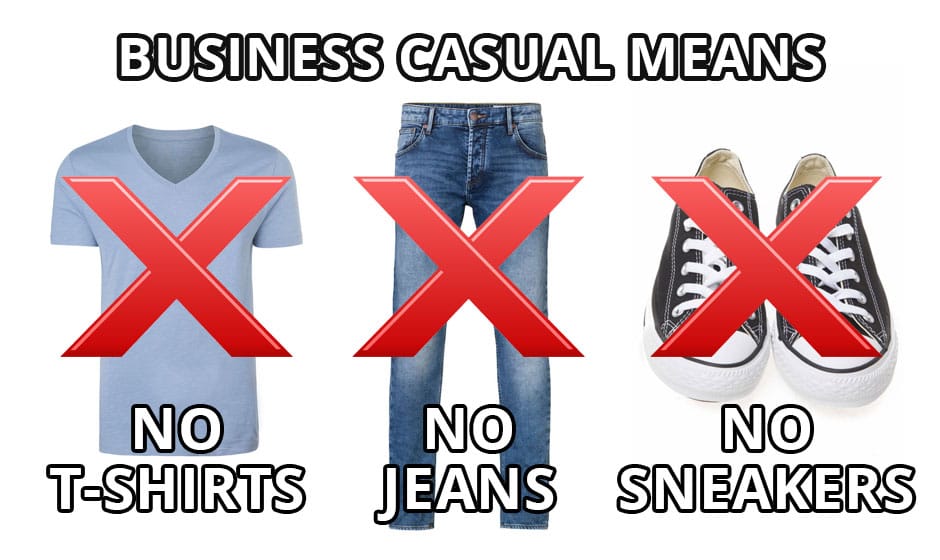
Business-casual ranges from suits without ties to wearing just shirts and pants. Dressing down further would take you too far into casual territory.
Yes, you’ve seen great outfits that combine jeans and t-shirts with shirts and sports coats. But those looks are too casual for business-casual.
Always lean towards the business side rather than the casual side.
Note: Some companies will allow jeans, or even T-shirts, so you might get away with it. But ask yourself whether you want to wear clothes that you get away with or wear ones that make the most professional impression.
Once you’ve been to an office, you can just gauge the room and see what everyone else is wearing (though, I’d still recommend taking it up one notch).
But if you haven’t been there before and you’re unsure how they expect you to dress, then remember that overdressed is better than underdressed.
At least when you’re overdressed, you still present yourself as a professional. When you’re underdressed though, your potential client or boss might just think you don’t take your job seriously enough.
And that’s the last thing you want, right?
So always keep professionalism in mind, and when in doubt, dress up.
Wear the right clothes and wear them the right way…
The Essential Business-Casual Clothes And How to Wear Them Right
So by now you should have a clearer idea of what business casual looks like, and you have some basic guidelines to follow.
So let’s dig a little deeper and see which clothes you should wear and how to get the look right.
1. Dress Shirts
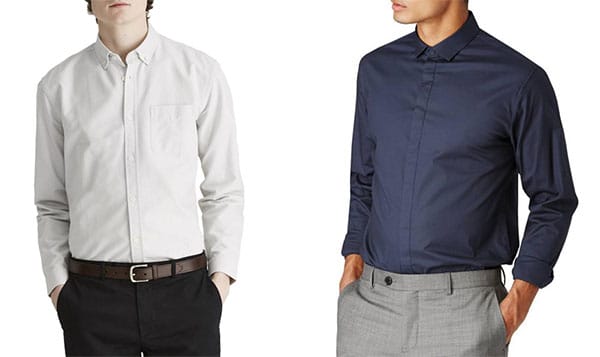
Image source: Frank & Oak
Dress shirts are business-casual must-haves. Every outfit we’ll cover in this article will involve a shirt.
Some offices also allow polo-shirts in summer, but only go there when the heat is otherwise unbearable (and you know your office allows it).
Otherwise, stick to dress shirts. Start off your wardrobe with shirts in traditional colors like white and light blue, but also consider alternatives like light pink, mint green or lavender.
And also consider subtle patterns like gingham or pinstripes. But avoid shirts that are too bold or trendy in design. Remember that you want to err on the conservative side.
Which reminds me — tuck your shirt in! An untucked shirt has no business being in a business-casual outfit. And unless you’re wearing a tie, leave your top two buttons undone (unless that shows too much skin or chest-hair; then just leave the top one undone).
2. Pants
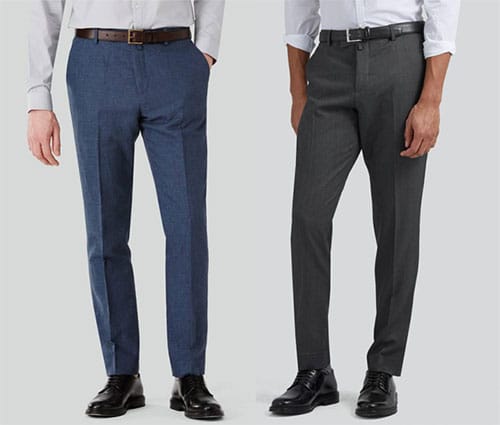
Image Source: Frank & Oak
I already mentioned that jeans are a no-go, so on your bottom half you want to wear either dress pants or chinos.
Make sure your pants fit well and don’t crease too much around the ankles. Go for a no-break to half-break.
And again, start off with more conservative colors like navy, grey or camel. If you do wear more colored pants, make sure they’re appropriately muted.
3. Shoes

Image source: Mr Porter
When you’re dressing business casual, the only footwear you want to look at is sneakers.
I kid, of course. Sneakers have as little business being in a business-casual outfit as T-shirts and jeans.
Some shoes you might consider are:
- Loafers
- Oxfords
- Derbies
- Brogues
Get a pair in black and brown so you have a pair of appropriate shoes to wear with any color of your pants.
4. Suits
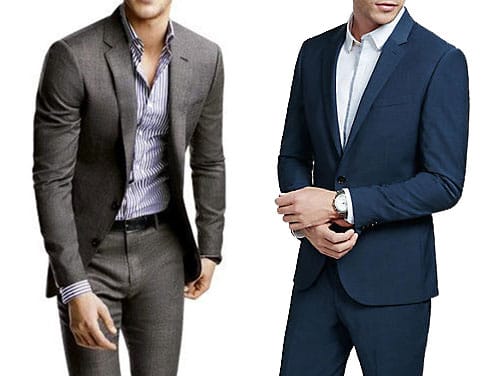
Some business-casual offices still expect you to wear a suit to work. They just allow you to leave the tie at home.
But even when you don’t have to wear a suit to work, doesn’t mean you never should. It still looks most professional (and handsome as well, so the ladies tell me).
And a suit will just come in handy when you need to step your personal presentation up a bit. What if you’re meeting an important client or have to give a presentation for upper management? Wearing a suit gives you the most professional image, even if you forego the tie.
5. Jackets

Image source: Frank & Oak
While some business casual offices still expect you to wear a suit, other are fine as long as you wear a jacket.
If that’s your situation, a navy or grey blazers a tweed sports coats and corduroy jackets are your basic go-to’s.
6. Sweaters/Cardigans
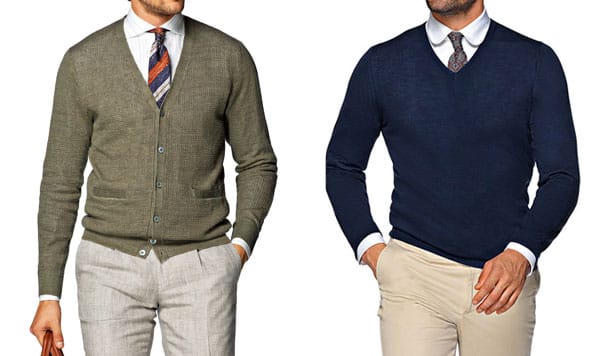
Image source: Suit Supply
Sweaters and cardigan also make fine layering pieces for a business-casual outfit.
In some offices, you may only wear them during winter, as a middle layer between your shirt and jacket. But other offices allow you to wear them as a substitute for your jacket.
But don’t think you can just wear that chunky Christmas sweater your grandma knit for you. Keep your sweater or cardigan lightweight and solid. Leave the chunky knits and bold patterns for more casual occasions.
You can be a bit bolder when it comes to color though, so don’t be afraid to lighten your office up with a pop of red or yellow.
7. Ties
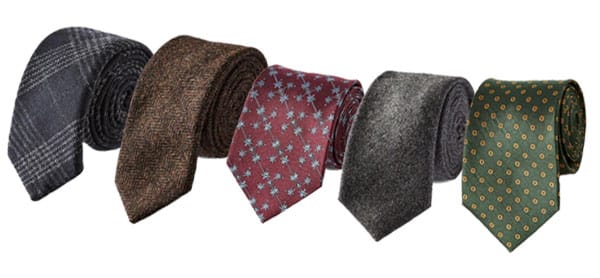
Image source: Frank & Oak
You don’t always need to wear a tie when you dress business-casual. In fact, the business-casual craze started with just leaving the tie at home.
But especially when you dress on the more casual side of business casual, a tie can make your outfit a bit more business-like.
For instance, you can wear a tie with a V-neck sweater or cardigan. Without the tie, the outfit is quite casual, but adding a tie dresses it up a touch.
It certainly works when you’re wearing a blazer and chinos as well though.
4 Simple Examples of Business-Casual Looks Done Right
Now that you know what clothes are essential for dressing business casual, let’s cover a few examples of looks you could put together.
I’ve ranked these from most formal to least formal, and as I’ve said before, which one’s most suitable depends on your office. But if you’re unsure, start with the top one, and dress yourself down from there.
Better to be overdressed on the first meeting than underdressed, remember?
1. The Suit Sans Tie
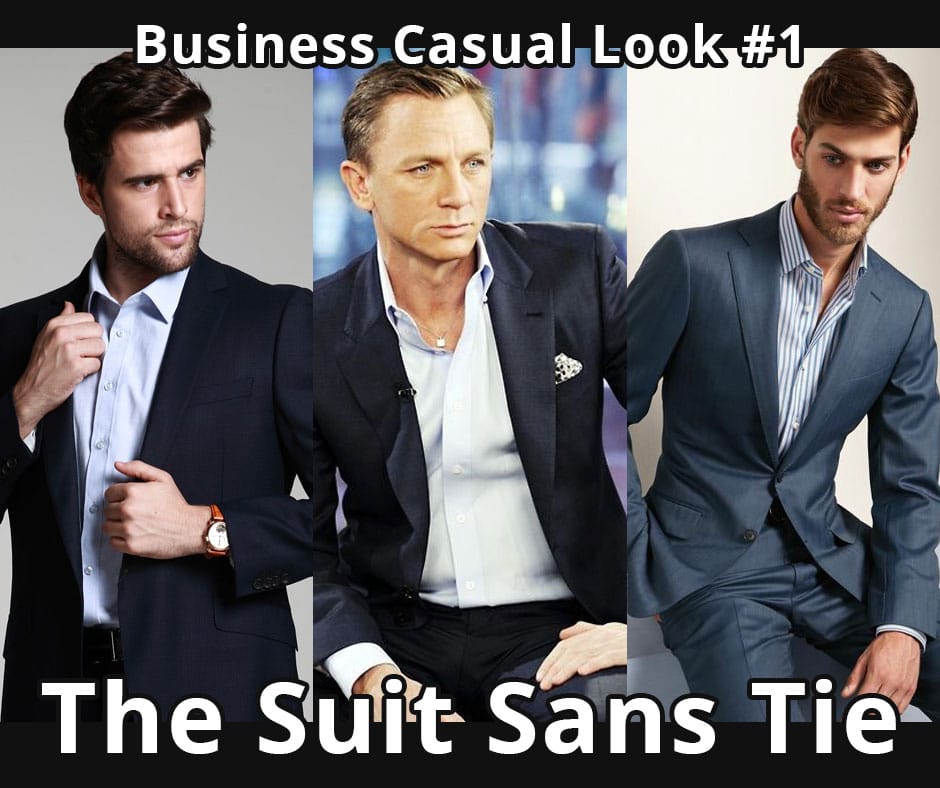
The first way to dress business-casual is to simply wear your suit without the tie.
This is just one step down from business-formal and still looks the most professional.
Also make sure to wear a nice watch that’s not too blingy. A leather strap with a subtle silver or gold face is fine. Avoid silver or gold straps.
And consider sprucing the outfit up a bit with a pocket square. You’re going without a tie, which frees up the neck, but also diminishes the visual interest some. Adding a pocket square will fix that.
This outfit is actually quite safe when it comes to dressing business casual. When you arrive at an office that’s one rung down on the dressy ladder (i.e. look #2), you wouldn’t stick out too much in a suit sans tie. And if you arrive at an office where the dress code is more casual (i.e. look #4), you can just take off your jacket to fit right in.
Simple, right?
2. The Odd Jacket
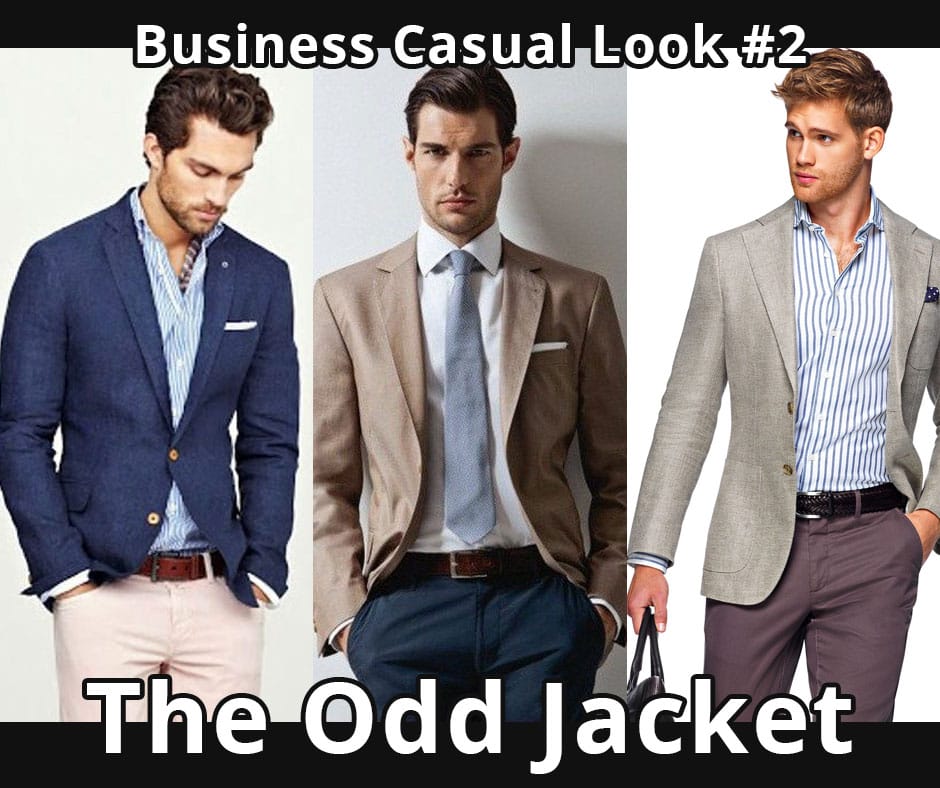
The term odd jacket isn’t used much anymore, but it means a jacket that wasn’t made with a matching pair of pants. Whenever you wear a jacket with pants that don’t match the color and fabric of the jacket, you’re wearing an odd jacket.
So that means your navy blazer, tweed spots coat or corduroy jacket.
You can pull this look off in two ways: With dress pants or with chinos. The dress pants will give you a dressier look whereas the chinos are a tad more casual.
Both looks will probably be fine if your office has this standard of business-casual, but the dress pants will give you a more professional edge.
3. The Dressed-Up Knit
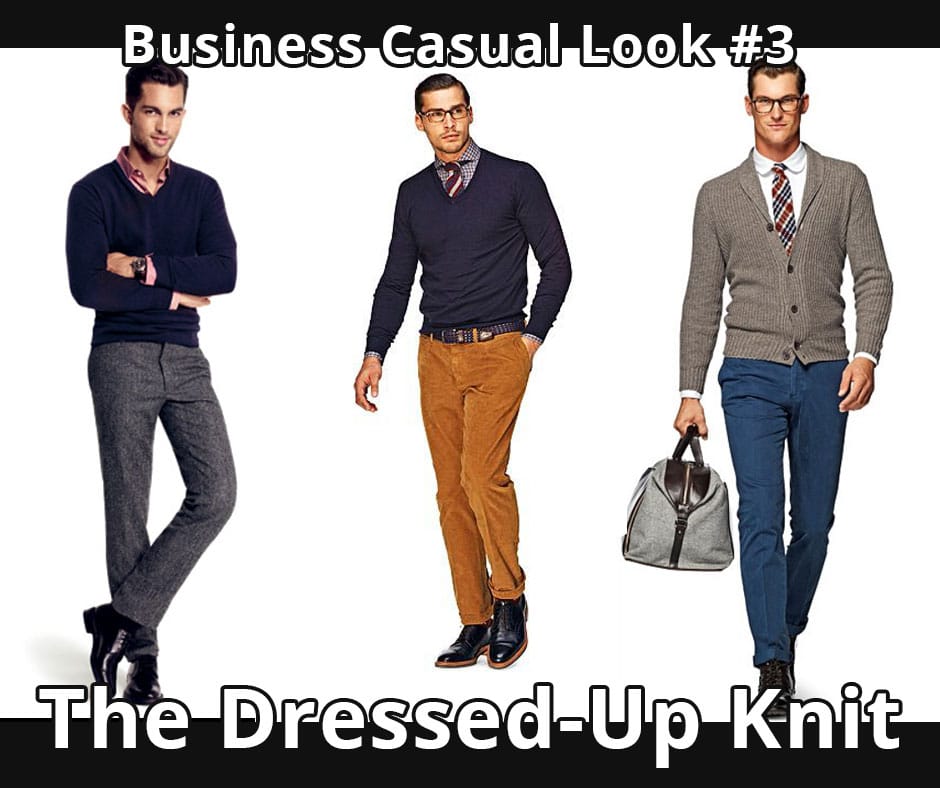
The dressed-up knit outfit has you wearing a sweater or cardigan instead of a jacket.
This look leans far more towards casual than the previous two, so I’d recommend pairing the knitwear with dress pants, rather than chinos. The latter works too, but dress pants will slide the look back towards business a bit.
And as I mentioned earlier, pairing a tie with your knitwear will have the same effect.
4. The Shirt & Slacks
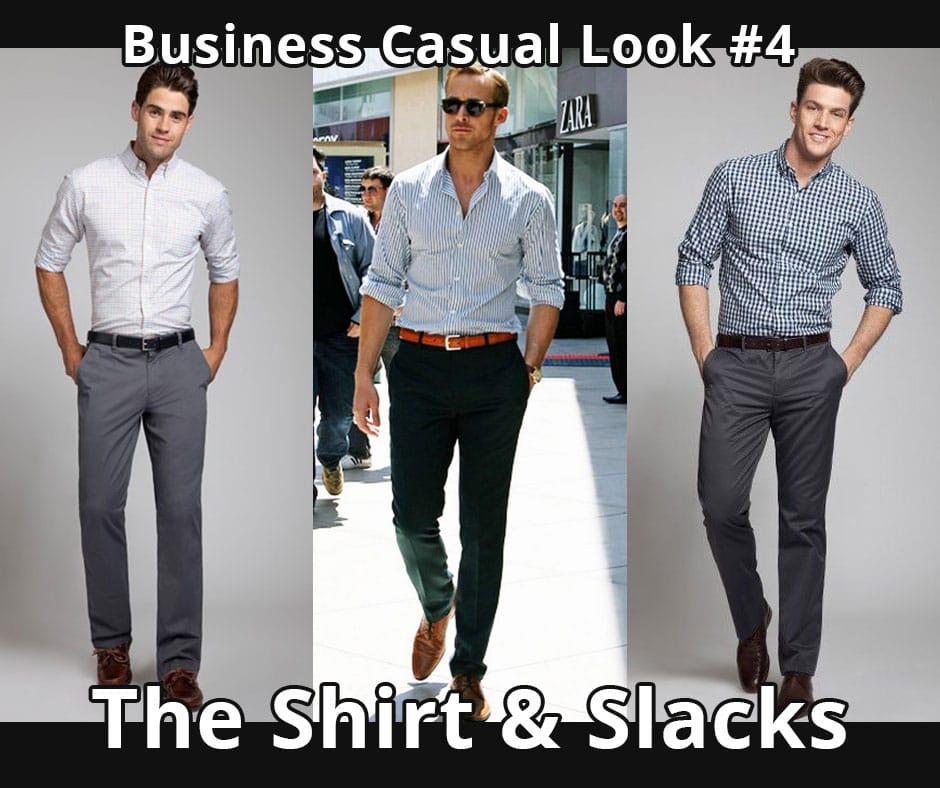
This is the most casual of the business-casual looks. It leaves both the jacket and tie at home.
Like with the previous look, go with dress pants rather than chinos to avoid venturing too far into casual territory.
However, unlike the previous look, don’t try to elevate this by adding a tie. Wearing a tie without a jacket makes you look boyish. It’s the outfit your mom made your younger self reluctantly wear to a wedding.
And that’s exactly the impression you’ll make, except now your boss makes you wear the tie and you refuse to go all the way with a jacket. Not a professional look, my friend.
So either wear a jacket and tie or wear neither. You can take the jacket off as you sit down to work, or even carry it on your arm as you move from your office to a client’s. Just having it around will make the tie look deliberate.
Be the Guy That Gets Business-Casual Right
Now you know how to make business casual work. So don’t be the guy that emphasizes the casual when you have to dress business casual. Be the guy that gets it right.
Even if the rest of your office is wearing jeans, just hold yourself to a higher standard. Take it one step up. Be the guy that look professional, even if you’re the only one. You’ll stand out in the right way.
The people who matter will notice.
The post The Sharp Man’s Guide to Business-Casual Attire appeared first on Restart Your Style.


















